One of the many beautiful things about the Cannabis plant is that it comes in many different types of weed plants. Not one marijuana type is exactly the same, and they also come in both the male and female variety. Some are tall and skinny, others are short and stout, and still, others are much smaller.
Types Of Marijuana
- Historical origins of marijuana types
- Marijuana type #1: Cannabis Sativa
- Marijuana type #2: Cannabis Indica
- Marijuana type #3: Cannabis Ruderalis
- Industrial hemp marijuana types
- Hybrid marijuana types
- Male cannabis plants
- Female cannabis plants
- Hermaphrodite cannabis plants
- Types of marijuana seeds
- The sinsemilla growing technique
- THC and CBD
The Cannabis plant is also known for its dioecious nature, meaning that it forms into distinct colonies of male and female plants. This is one of the reasons growers develop issues with male plants invading a grow room.
In addition to male and female plants, growers and cultivators are likely to run into (and create!) hermaphroditic and androgynous plants.
Whichever type of marijuana you ultimately choose to grow, it is a good idea to gain some basic knowledge of the variations and the differences between the different species, as well as male and female plants. You’ll also want to understand the reasons why you’d want to separate them.
When you know these things, you can make the best decision for your own growing habits. In this article, we will cover the three species of cannabis, the role of gender in growing as well as hybrid breeds and hermaphrodites.
Historical origins of marijuana types
There is actually no official scientific evidence that explains the differences between Indica and Sativa strains of marijuana or even confirms that these differences exist. Nonetheless, they are widely accepted facts among the marijuana growing and using crowd.
There are some historical explanations for the beginnings of the Indica strain, also known as Cannabis Indica. It was first classified by Jean-Baptiste Lamarck, a French biologist, in the late 1700s. He also identified the fact that the plants were intoxicating.
It was different from the regular hemp crops grown in Europe at the time, as they did not intoxicate the consumer.
Because of the differences between the European hemp crops (then actually known as Cannabis Sativa), Lamarck named his Indian discovery Cannabis Indica to establish its uniqueness from the European hemp. It was considered a therapeutic remedy of sorts in Europe during the 1800s and commonly used in Western medicine.
Marijuana type #1: Cannabis Sativa

Sativa is the marijuana type that people seem to like smoking the most. This plant grows quite large, reaching up to 15 feet in some cases. While it is not a really thick plant, many growers like it due to how tall it can grow.
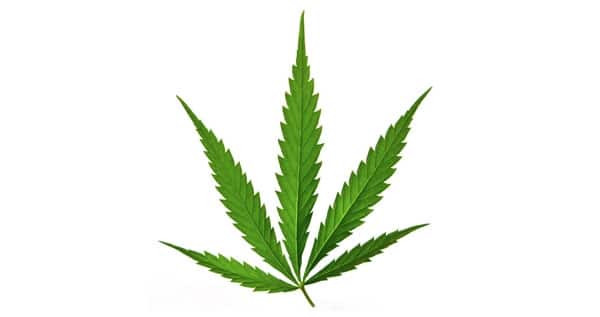
Their leaves are long, dainty, narrow, and considering their height potential, these are perfect for outdoor growing. The seeds are soft to the touch, with no spots or markings on them.
Do not expect this plant to flower quickly because Sativa takes its precious time, and even shifting the light cycles could have little effect on this.
Grow Bible

- Grow with my Quick Start Guide
- Discover secrets to Big Yields
- Avoid common grow mistakes
Error: Contact form not found.
Sativa is usually found below a latitude of 30° N, in places like India, Thailand, Nigeria, Mexico, and Colombia.
Sativa is often dried, cooked and consumed. While many people either vaporize or smoke this strain, it is the norm for users to use this to get high.
“You are not going to get stoned from using Cannabis Sativa, but it does have an invigorating, pick me up kind of effect that leads to feeling happier, unlike its more sedating counterpart, Indica.”
— Robert Bergman
It also can enhance your creativity, depending on the person. This is the strain you use when you want to be up and active during the day since it raises your energy and opens you up to fresh, new ideas.
If you are an artist of some sort, you may love this one. Sativa is known for a high ratio of THC to CBN the two primary active ingredients in cannabis.

Sativa dominant strains are higher in the THC cannabinoid. This makes it less likely to be used for medicinal purposes, but it is still common in Ayurvedic medicine. They also work well to combat the symptoms of:
- Depression
- ADHD
- Fatigue
- Mood disorders
Growing Cannabis Sativa
Cannabis Sativa is a type of marijuana that typically flowers for longer, has lower yields than Cannabis Indica, and has characteristically long thin leaves.
They’re taller plants in general since they come from a region near the equator, which has longer summers (which is also why their flowering period naturally lasts longer).
A good thing about growing Cannabis Sativa is that the vegetative phase is shorter. There are even some Sativas out there bred to have shorter flowering phases.
If you’re from a hotter climate or have trouble keeping your grow room temperatures down, then a Sativa might be for you — they can take high temperatures better than Indicas.
Marijuana type #2: Cannabis Indica

Cannabis Indica is a more solid strain in comparison to Sativa, but it does not have the height Sativa achieves.
Indica strains generally grow between 3 to 6 feet tall (1 to 2 meters. It is a bushy plant with round healthy leaves, unlike Sativa. However, they both have marbled colored, soft seeds. Being that Indica is a short plant, this one is perfect for indoor growing.
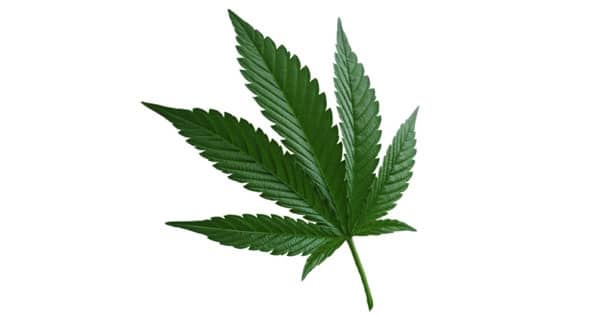
While Sativa takes some time to flower, Indica flowers much faster and can be influenced a lot easier by adjusting the light cycle to promote this phase. It is most commonly found above 30° N, in countries like Nepal, Lebanon, Morocco, and Afghanistan.
The buds and flowers on Indica dominant strains will usually grow very close to each other and are stickier to the touch than Sativa plants. When you want to make hashish, Indica is the plant you would choose due to the amount of resin it contains.

“Cannabis Indica is a stoner’s favorite since it is more like a sedative and puts your entire body into a deep state of relaxation. It has so much CBN in it that it will surely take you far and beyond just a regular high.”
— Robert Bergman
Cannabis Indica has lovely healing qualities, and helps with:
- Insomnia
- Alleviating pain
- Inducing relaxation of muscles
- Muscle spasms
- Calming anxiety
- Headache and migraine relief
Growing Cannabis Indica
Cannabis Indica is a strain of medical marijuana that is typically higher yielding, has a shorter flowering time, and has leaves that are shorter and wider than a Sativa’s. They’re smaller plants in general, but they can get quite bushy. Lots of growers prefer growing Indicas for these reasons.
Because of their shorter flowering phase, people who grow in colder climates with shorter winters may want to grow Indicas. Because of their shorter height, growing them indoors is also easy when it comes to growing Indicas.
Check out our more in-depth guide on the differences between Indicas vs Sativas!
Marijuana type #3: Cannabis Ruderalis
You will rarely hear anyone talking about Cannabis Ruderalis, which is one of the primary marijuana types and has a pretty short stature growing between 20-25 inches in height. Similar to Indica, this plant has very thick foliage. This plant is usually found growing in northern regions of the world.
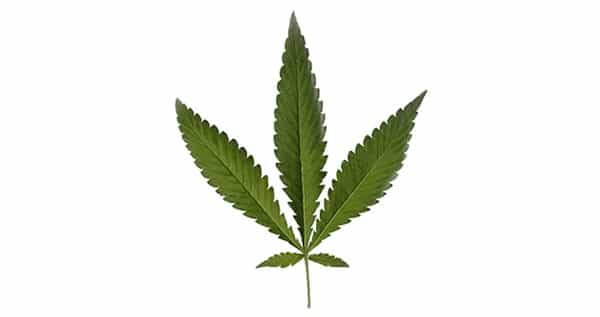
Ruderalis has an extremely early and fast flowering cycle because it grows farther north than any other type of marijuana and so doesn’t have the luxury of a lot of time to mature before cold weather hits. Ruderalis is used to produce autoflowerers.
One of the reasons you hear little about this strain is because it is not known to be highly psychotropic. It is used primarily as a source of additional genetic material by breeders and cultivators. That way, hybrids which flower early can be bred, and certain strains can be adjusted so that they will grow in more northerly climates.
Industrial hemp marijuana types
Industrial hemp or hemp, typically found in the northern hemisphere, is a type of marijuana originating from the Cannabis Sativa species that is grown specifically for the industrial uses of its derived products. It is one of the fastest growing plants and was one of the first plants to be spun into usable fiber 10,000 years ago.
It can be refined into a variety of commercial items including paper, textiles, clothing, biodegradable plastics, paint, insulation, biofuel, food, and animal feed.
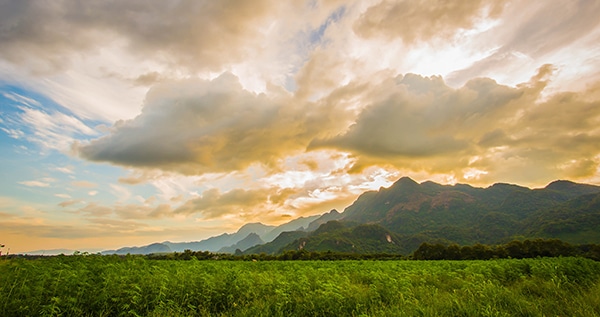
Hemp was a cash crop in America until the passage of the 1937 Marihuana Tax Act, partially because hemp can grow wild in climates where winter doesn’t freeze the soil and kill the seeds. According to the USDA, hemp has a low THC content and isn’t worth smoking. With THC levels below 0,3%, I totally agree.
Hybrid marijuana types
In modern cannabis cultivation and breeding, there are a huge number of varieties available. Many years of intense mixing and hybridization have created a huge spectrum across these three primary varieties.
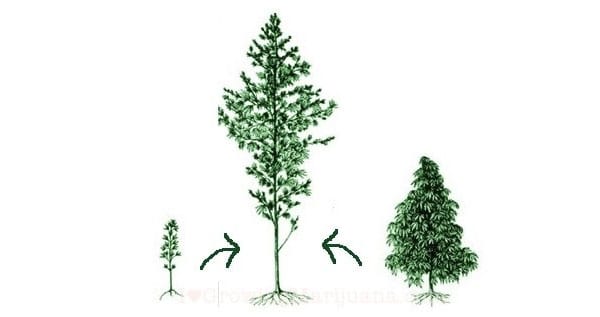
The different mixes all have different characteristics, running the gamut of possibilities relating to flowering cycles, yield, CBN:THC ratios, and disease resistance, among others. In general, the purpose of a hybrid plant is to combine positive characteristics from different strains together.
Some key differences between Indica and Sativa marijuana types are the height of the plants, the length between buds, the size and shape of the leaves, the odor, the quality of the smoke, and the chemical properties themselves. In general, Indica is wide and robust while Sativa is long and thin.
Growing Hybrids
Hybrids can vary greatly, but usually, they have some of the good qualities of both Sativas and Indicas. Because of the range of genes you can find in hybrid marijuana plants, it’s hard to specify a common height, leaf shape, or other distinguishing detail. However, hybrids are often bred to have higher yields and be more pest-resistant, which is great for growers. Hybrids are extremely popular. Most of the seeds available are hybrids. To know what you can expect, be sure to read the growth descriptions before buying.
Male cannabis plants
When male-sexed cannabis plants finish maturing, the flowering process occurs all across the plant. Tiny racemes (short flower stalks) are formed at the base of the flower itself. When the flowers open, the plant releases a load of airborne pollen which sticks to and is absorbed by the pistil of the female plant.
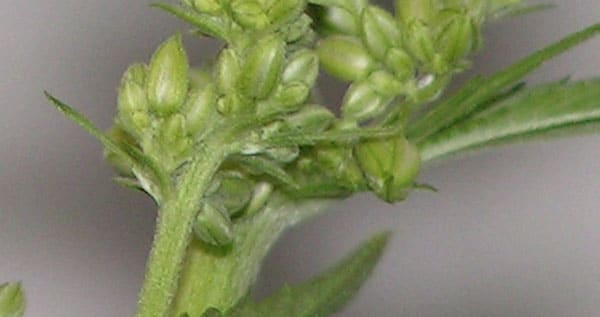
This is a basic explanation of how the fertilization and reproductive process in cannabis plants works. It can be difficult to distinguish between male and female plants at times, but the male usually has earlier sexual development.
Female cannabis plants
Like male cannabis plants, mature females will also produce racemes. In the case of the female plants, the racemes are a blend of tiny pistils and calyces (calyx). In each of the calyces, there is an ovule, which acts as the receptor for the pollen from the male plant.
When the grains of pollen stick to a pistil, the pistil stalk then pushes into the calyx, and the plant is fertilized. The calyx itself is also the site where cannabis seeds are grown after fertilization.
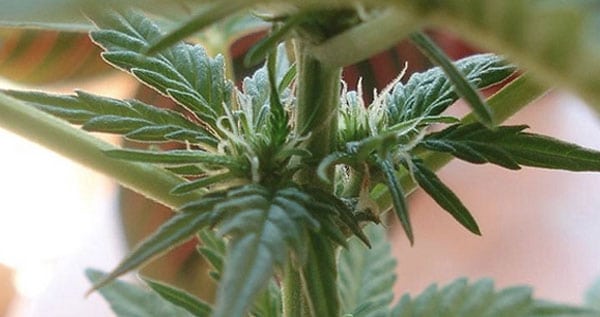
Each seed will have a mix of characteristics coming from both parent plants, as in other instances of sexual reproduction. The only time this wouldn’t be the case would be if the parent plants were identical, as in the case of certain pure clones or specific hybridizations.
Hermaphrodite cannabis plants
Although rare as a natural occurrence in nature, many growers might be exposed to the existence of hermaphroditic plants, that is, plants that contain both male and female sex organs. These sorts of plants can fertilize themselves, which is both extremely interesting and potentially quite useful from a breeding perspective.
In general, a hermaphrodite cannabis plant falls on one of the three points along a sexual spectrum. If the plant is mainly comprised of male flowers or has a roughly equal number of male/female flowers, it is probably of little use to a grower. If the hermaphrodite has mainly female flowers, however, it should definitely be saved.
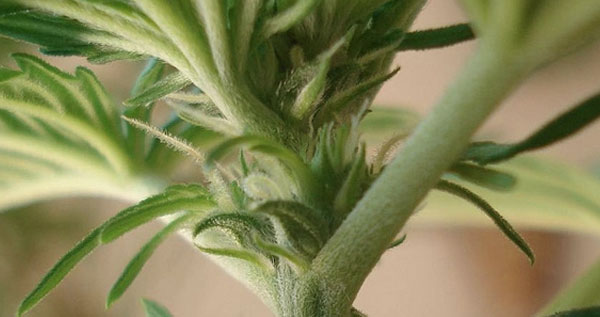
The pollen from these plants can be quite useful, and some growers collect the pollen because even though it is a male part of reproduction, the hermaphroditic pollen is genetically female, and will produce female flowers.
In the ’70s, Indica strains were brought to the USA and mixed with the already present Sativa plants, which set off a long chain of breeding and experimentation with cannabis cultivation and hybridization.
Tip: make sure to download my free Grow Bible for more information about types of marijuana
Grow Bible

- Grow with my Quick Start Guide
- Discover secrets to Big Yields
- Avoid common grow mistakes
Error: Contact form not found.
It’s important to note that despite the differences between all of these types of marijuana, they are essentially one species. They can still be bred together. The names Indica and Sativa refer to the areas where the plants are originally from.
The same sort of idea is found in other agriculture, or dog breeds, where there is a wide difference in appearances, but the species are still the same.
Types of marijuana seeds
There are few aspects of marijuana plants that are more important than the seeds. Everything begins with the seed, so you’d better make the seed count. In other words, you should carefully decide what type of seed you would like to buy. Let’s look at some of the options.
Regular marijuana seeds
Regular seeds are, just as they sound, the normal type of marijuana seed that most people have traditionally grown with. These seeds will come with approximately 50% male and 50% female, so you will have to diligent about removing the males if you are growing with feminized seeds.
Feminized marijuana seeds
These seeds are ones that will only produce female plants. These aren’t naturally occurring — they need to be created to get them to be all female (which is also a marijuana grower’s dream). Buying feminized seeds is the most efficient option for most marijuana growers.
Autoflower seeds
Seeds that autoflower are not photosensitive, instead they start to flower based on timing. In other words, they flower automatically. These can work really well for growing all year round, although it doesn’t make much sense for indoor growers who already can decide when they want their plants to begin flowering by manipulating the light cycle.
Once the plant is fully grown you will need to start thinking about harvest time. Our free little Harvest Guide will help you determine the best moment to cut your plants. Download it here.
The Sinsemilla Growing Technique
Sinsemilla is a type of growing marijuana where only female plants are allowed to blossom. This is done so that male plants don’t get the opportunity to fertilize the females. This is done because many growers don’t want seeds in their plants at all, although there are always exceptions.
It’s highly advised to keep grow rooms and male pollen as far apart as possible unless there is some express purpose for fertilizing the plants. The yield will drop substantially, and the taste of the plant will be ruined.
In general, it’s highly desirable to have unpollinated female plants, because more of the energy is devoted to producing cannabinoids and buds that are valuable to the grower, rather than being expended on sexual reproduction organs and seeds.
Unpollinated plants will have more sugar, THC, and much denser more odorous flowers. This is ideal, especially for medicinal purposes, where the efficiency is very important for any patients who are in need of the active ingredient.
What are THC and CBD?
You’ve likely heard of CBD and THC before. These two substances are the reason behind all the hype surrounding marijuana. There are some significant differences between the two of them, so let’s look at what each of them does.
THC
The abbreviation “THC” stands for Tetrahydrocannabinol. It provides the psychoactive effects of marijuana, affecting the brain more than the body. Another substance, called anandamide, is mimicked by THC to make the brain function differently with memories, higher cognitive processes, and fine motorics.
It also affects pain, fertility, hunger, and depression. Plenty of people choose strains of marijuana that are high in THC for its medicinal benefits. More about THC in my article What is THC?
CBD
Cannabidiol, or CBD, is another psychoactive substance that is commonly used in medical marijuana. The two interact, with the CBD having an influential effect on the THC, meaning they could strengthen or weaken certain effects of THC. Suppressing the psychedelic effects, for example, can be a big plus in a medicinal strain of marijuana.
These are in no way the only two types of cannabinoids. The other ones, however, are only present in smaller amounts. More about CBD in my article What is CBD?
FAQ About Types of Weed
There are three main types of weed; Cannabis Sativa, Cannabis Indica, and Cannabis Ruderalis.
The two common types of weed are Cannabis Sativa and Cannabis Indica.
Hybrids are created by combining the good qualities of different strains of weed. They tend to have higher yields and are also pest resistant.
Thanks for reading. If you have any questions, if something is unclear or if you’d simply like to learn more, then leave a comment or questions below and don’t forget to download my free grow bible
Robert
The post Types Of Marijuana – Sativa, Indica and Ruderalis appeared first on I Love Growing Marijuana.
